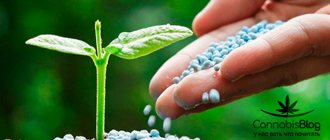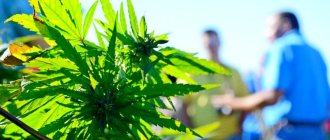With the arrival of summer, when it becomes warm and everything around is blooming, there is a desire not to miss the hot energy of the sun and take your favorite hobby to the open ground. At outdoor growing (from English. growing outdoor
- growing outdoors) has its own characteristics, which will be discussed today.
Growing Basics
Before you start growing hemp, you need to know what kind of plant it is. You don't have to become an expert in everything, but a would-be grower should understand at least the basics: the life cycle of cannabis, what fertilizers it needs, how to plan for harvest, etc.
Here are some facts that any grower should know.
- Cannabis is a flowering plant that can be male, female or hermaphrodite.
- It can be grown indoors, outdoors and in a greenhouse.
- In the wild, male plants pollinate female plants, and seeds appear on their inflorescences. Most growers try to avoid such situations, as seedless buds are noticeably better in quality.
- There are three main categories of cannabis strains: indica, sativa, and ruderalis. They all differ somewhat from each other in their appearance and effects.
- Indica and sativa plants are natively photoperiod plants, meaning they flower when they begin to receive 12 hours of light per day. Ruderalis (autoflowers) bloom automatically - this depends on their age, not on the light.
- The life cycle of cannabis is divided into three main stages: seedlings, vegetation and flowering.
- In nature, cannabis is an annual plant, its life usually begins in the spring or early summer. The duration of the life cycle can vary greatly and ranges from 4 to 10 months.
Feminized Automatics THC 31% | Best Seeds from Holland
Advertising errors-seeds.com.ua ▼
Top Varieties of Ukraine and Spain! Huge Selection of Seeds at Low Prices. Stock. Comfortable. Safely. Discounts. Types: Autoflowering, Low growing, Feminized, Sativa, Indica, Harvest
Growing marijuana can be a fun and rewarding experience, or it can be a complex and expensive project. The good news is that even a small garden can grow quality cannabis without a large investment. If you have access to a vegetable garden, balcony, deck or rooftop, you can successfully grow cannabis. We'll cover how to grow in open soil and the different factors to consider.
Factor 1: Climate
It is extremely important to understand the climate conditions in your region. Cannabis is very adaptable to different conditions, but does not like sudden changes in weather. Hot temperatures above 86°F and cold temperatures below 55°F will kill or damage plants. Heavy rains and strong winds can break branches and reduce yield, and excessive moisture can lead to mold, especially during flowering.
In addition to weather conditions, you need to know how day length varies in your area. For example, latitude 32°N (San Diego) has 14 hours of daylight during the summer, and latitude 47°N (Seattle) has 16 hours of daylight.
We advise you to find a useful web resource “Map of Climatic Zones”. Use local resources and advice from experienced gardeners. If you have gardening experience growing vegetables, you will find growing cannabis outdoors quite easy.
Factor 2: Growing Space
Choosing a location for your garden is especially important if you are planting in open ground. Your cannabis plants should receive at least 5-6 hours of direct sunlight per day, ideally during midday when the quality of light is best. If you live in an area with daytime temperatures above 86°F, choose a location with direct sun early in the day. If you live in an area with strong winds, try finding a windbreak: a wall, fence or large shrub will do. If you're growing in a cool climate, choose a location close to an object that retains heat: this could even be a brick wall. Of course, you want to maintain the privacy and security of your crop. Most people hide and hide their plants from neighbors and potential thieves. Try planting behind a high fence, bushes, or trees, unless you live in a secluded area. Remember that outdoor cannabis plants can grow up to 15 feet or more, so plan accordingly.
Factor 3: Soil
Cannabis soil consists of three main components in varying proportions: • clay • sand • soil Cannabis plants need slightly acidic soil rich in organic matter. If you decide to plant directly in the ground, you need to know the composition of the soil.
JahForum is launching its Youtube channel!
Heavy clay soils do not retain oxygen well. A month before planting, dig large holes for future cannabis plants and place compost, manure, and other organic fertilizer there. This will provide aeration and drainage, as well as nutrients for the plants.
Sandy soil is easy to work with. It heats up quickly but contains no nutrients. You will need to dig large holes for the plants and add compost, peat moss and coconut shavings. In hot climates, sandy soil should be mulched to retain water.
Good soil is the ideal growing medium. It heats up quickly, retains moisture, has good drainage, and contains many nutrients. The best soil is dark and crumbly: it does not need any additions.
If you really want to ensure good results, then do soil testing and learn about soil pH.
Factor 4: Fertilizers
Cannabis needs fertilizers during its life cycle: nitrogen, phosphorus and potassium. Use commercial fertilizers if you have a good understanding of how they work. For beginners, it is best to purchase nutrient solutions formulated specifically for cannabis at the store. You can find many different natural and organic fertilizers in the store, such as bone meal, fish meal, and algae meal. Try inexpensive fertilizers. You can mix several fertilizers to provide adequate nutrition for your plants. Again, if you know your soil, you can tailor the type and amount of fertilizer. If you don't know the soil conditions, be conservative: don't apply too much fertilizer to avoid burning the plants.
You can buy super soil. Either way, it's a little more expensive, but it will have all the nutrients it needs. Dig large holes for your plants, fill them with super soil.
Factor 5: Water and irrigation
Cannabis likes to be well-watered during its growing season, especially during the hot summer months. Large cannabis plants use up to 10 gallons of water in warm weather. If you are growing in hot, dry areas, dig drainage or funnels for water.
If you live in a rainy climate, you can drain the soil. Try these methods: • Planting on raised terraces • Ditches • Add gravel or perlite to the soil
If you use tap or well water, check its quality. Water may contain high levels of dissolved minerals, which can accumulate in the soil and affect pH levels. Plants in containers dry out much faster than those growing in the ground. They need to be watered every day. Plants grown in hot and windy conditions also need to be watered. High temperatures cause the plant to develop at a faster rate. Remember that overwatering is the most common mistake made by beginners. Buy an inexpensive soil moisture meter to help you stay on track.
Friends, This Day Has Come! Error-seeds Company Birthday!
Factor 6: Container planting
Container planting is a good choice for beginners. This method has many advantages, but there are also disadvantages. If you don't want to dig and work hard, containers can help you grow cannabis.
If you don't have a suitable plot of land, containers can be placed on balconies, patios or rooftops. Alternatively, you can use regular houseplant fertilizers.
The benefits of containers are great for beginners! Plants grown in pots, buckets or barrels will be much smaller than plants grown outdoors. The size of the container determines the size of the plant.
We recommend using five or ten gallon (20-40 liter) containers. You need to protect the plant roots from overheating in warm weather, as the container may overheat on a hot day. Overheating will severely limit the growth of your plants. Water plants in containers frequently throughout the summer.
Factor 7: Protection
You need to know how to protect your plants from storms and other weather events that can damage or even kill them.
Temperature Changes Temperatures below 40°F can damage most cannabis strains, so if you live in a climate where late spring or early fall frosts are common, use some insulation.
Wind Strong winds can break branches and damage trichomes. If your plants are in a particularly windy location, we highly recommend installing some kind of wind protection. This could be a wall made of plastic sheets.
Rain Rain is good for cannabis, although a lot of rain is usually seen as a nuisance. Rain can seriously damage your crops and cause mold during flowering. Choose a variety that is mildew resistant.
Pests Keeping your cannabis plant free from pests can be challenging. You can build a fence to keep out animals such as deer and rabbits, and cover insects with mesh. The best defense is to keep your plants healthy. Cannabis plants are naturally resistant to pests. Plant plants away from other flowers, vegetables and ornamental plants.
Check your cannabis plants daily for signs of pests. It is much easier to deal with an infection at an early stage. A mild solution of soap and water can stop the infection. In case this doesn't work, there are many organic insecticides made for cannabis. They are quite effective when used correctly.
A little about security
Factor 8: Genetics Choice
Bad climate. Some varieties cannot adapt to bad climates, especially sativa varieties. Cannabis will flower when the days begin to shorten. Sativa grows well in areas closer to the equator where day length does not vary. When you try to grow sativas in northern latitudes, they don't get enough sun to ripen. If you live in southern California, you can grow these varieties without any problems; and in Seattle or Vancouver, they simply won't produce due to lack of light, heavy rain and cold weather.
Seeds or clones? Some growers prefer to use clones (cuttings that are genetically identical to the plant). But when growing outdoors, it is better to use seeds. Both options have their advantages and disadvantages. Cloning requires a "mother plant" that is set to 16/24 hours of light per day to prevent it from flowering. You can purchase clones from the store. The advantage of this method is that the "mother plants" produce quality cuttings and all clones will be female plants. These clones are usually started indoors and then transplanted outdoors.
One of the disadvantages of clones is that they are less hardy than plants from seeds. In addition, clones have weak root systems, so they are more susceptible to strong winds and drought.
Plants from seeds are more hardy. Cannabis seedlings are tolerant of low temperatures and wet conditions, meaning you can plant the seeds directly in early spring. The main disadvantage of seeds is that there is no guarantee of a good harvest - you don't know what you'll get. Each cannabis seed is unique! You can't be sure what the final product will be. Additionally, regular cannabis seeds produce male and female plants. You will have to remove all male plants to avoid spoiling the harvest. For this reason, many beginners and experts choose feminized seeds.
Autoflower seeds are another popular choice for growing outdoors as they begin flowering as soon as they reach maturity, regardless of day length. Many gardeners get two harvests a year using these seeds.
You now have enough knowledge to successfully start growing cannabis. This is a pleasant and useful activity! Enjoy!
Headings: News, Problems Tags: growing, hemp in open ground, hemp, news, weed
We also recommend reading:
- Growing Cannabis and Using Silicone While cannabis is fairly easy to grow, experienced growers sometimes use various additives. These are supplements that improve […]
- How to Make Feminized Cannabis Seeds Cannabis plants can grow either male or female. While male plants play an important role in the reproduction process, […]
- 10 years! We continue to work and grow your dream! Dear friends! The online cannabis seed store Errors Seeds is 10 years old! We want to make our anniversary, tenth day [...]
- Outdoor Grow-Report “Moldavanka 2016” Hello like-minded people! I decided to start a mini-report, a report. Better late than never. A little background. I am in the republic [...]
- Indoor: Advantages and Disadvantages of Autoflowering and Regular Flowers When the main goal of cannabis cultivation for a grower is high yield, it is better to plant autoflowering seeds and start training him. […]
- Using Ladybugs to Protect Your Cannabis Garden If you're like most people who grow cannabis, you probably prefer to eradicate any pests that are destroying […]
- Photo competition “HalloWeed 2018” In 2018, traditionally, the entire growing community will celebrate Halloween on the night of October 31 to November 1. To preserve bright [...]
- Friends, This Day Has Come! Error-seeds Company Birthday! In 2018, the company that dared to take the risk of becoming the first seed bank in the CIS turns 9 years old. We are, of course, talking about [...]
leave a comment
Click to cancel reply.
Price
Growing hemp costs money. Depending on how professionally you want to do this, you may have to invest in expensive equipment.
Exactly what you need will depend on your skills as a grower and the number of plants you plan to have. Here is the required minimum:
- lamp;
- exhaust fan;
- grow tent;
- air filter;
- reflector;
- table fan;
- timer;
- pH meter.
Buying and operating the equipment will certainly hit your pocket, but it will serve you for quite a long time, and after several harvests you will compensate for your initial costs.
Note. The costs of growing hemp do not always have to be high. Some growers can achieve great results with as little as $100, while others will need to invest up to $1,000 on professional equipment.
Northern climate: cold, northern latitudes
Northern climates tend to have lower average temperatures and shorter days and planting seasons. A number of varieties with a short flowering stage have been specially bred for growing in such difficult conditions, as well as autoflowering varieties that are ready for harvest much earlier than many conventional photoperiod varieties.
In cool climates, where the sun is not as drying as in the south, varieties with high mold resistance will ripen best, as well as varieties that grow in the mountains and withstand the cold well.
Hemp cultivation methods
Cannabis can be grown in different ways. Before you get started, read about the different methods and choose the one that best suits your skill level and budget.
Perhaps most often, hemp is grown in soil. At the same time, growers feed it with fertilizers - purchased or organic (for example, compost).
Alternatively, you can use an inert substrate (coconut fiber, a mixture of perlite and vermiculite) or a hydroponic system. The choice is entirely up to you, but inexperienced growers may find it easier to start with potting mixes.
Who invented heroin?
Papaver somniferum has been grown in the Middle East since about the middle of the 4th millennium BC. e. Many scientists believe that the elixir called nepenf, which Helen of Troy drank in Homer's Odyssey to forget her troubles, is opium. In the 5th century BC e. Hippocrates recommended it as a painkiller. References to its use as a recreational drug date back to the Middle Ages.
Since the 17th century a mixture of opium with some other ingredients was sold as a medicine under the name laudanum. At the beginning of the 19th century. doctors were able to extract morphine from the plant. But the most popular and potent remedy based on it was introduced in 1898 by the pharmaceutical company Bayer. And what did she call him?
Heroin. The company sold it as cough syrup for children and adults for only ten years, but drug users began to try it and began to use it recreationally.
The alarming rate of heroin's spread forced the US government to tighten measures, and by 1923 it was completely banned. Nevertheless, its use continues to grow, and today at least 3.5 million Americans, by their own admission, have tried this drug at least once in their lives.
According to the World Health Organization, there are now at least 9.2 million users of this potion in the world. About 90% of the world's opium production comes from Afghanistan.
Place
Choosing where to grow your cannabis is an important part of the process. You need to think about this a lot in advance. Basically, you have two options: grow cannabis indoors or outdoors. In both cases you can find your pros and cons.
Growing cannabis outdoors is great because it eliminates many of the costs. Thanks to sunlight, you don't have to buy a lamp. In addition, outdoors the plants will be blown by the wind and will not need any fans.
The main disadvantage of outdoor growing is that you will not be able to control many environmental parameters, such as humidity and light levels of the cannabis plant. Also, bushes growing outdoors are more likely to attract someone's attention.
There are many benefits to growing cannabis indoors. First of all, the plants will be out of sight of other people. You will also have complete control over your grow tent's climate and adjust temperature, humidity, and lighting to create the perfect growing environment for your cannabis.
The main disadvantage of this method is the high cost: you will have to buy various equipment and maintain it, and your electricity costs will increase. However, do not forget that the free space in the room is limited.
Choosing an outdoor location and preparing the land
The second important stage is choosing a location. Here it is worth considering several factors: the illumination of the place, its accessibility, proximity to residential buildings and busy highways. For light-loving plants, it is better to choose an open place where sunlight reaches most of the day. The south side is perfect for this. Another trick is to plant plants in lowlands, so they will be protected from the cold in case of frost.
The soil in the selected area will rarely be good, so it is best to prepare it. Or in the fall, by digging up an area with fertilizers and humus (vermicompost). Or, just before planting, dig a hole and fill it with purchased soil mixed with coconut, perlite and vermiculite. When replanting a plant in a grow bag, there is no need to manipulate the substrate; root feeding will be sufficient. The bag will protect the root system of the seedling from pests living in the soil; even moles will find it difficult to dig under.
Pests and Nutrient Deficiencies
Hemp, like other plants, is susceptible to disease and insect infestation. In addition, it requires a lot of fertilizers and water: if you do not follow the feeding and watering schedule, this will have a bad effect on the quality and quantity of the harvest.
Fortunately, by learning to recognize the signs of pest and disease infestations and notice the symptoms of nutrient deficiencies, you can quickly eliminate them and minimize the devastating effects of these problems. Please note the following:
- If there is a lack of nutrients: the stems may turn red, the leaves turn pale, curl, become deformed, spots appear on them, and the growth of cannabis slows down.
- When pests and diseases appear: spots from insect bites appear on the leaves, the leaves themselves curl, turn yellow or brown, spots or white coating appear on them, cones may also suffer - they turn black or brown.
Recommended varieties for growing in northern climates
In Northern Europe, I recommend choosing indica or indica-dominant varieties, as well as autoflowering plants. Over the course of their existence, indica strains have developed the genetic characteristics necessary to survive in cold, mountainous regions with harsh winters and short summers.
There are many benefits to autoflowering, such as ruderalis genetics allowing you to harvest one more crop per year. This subspecies appeared in Central Asia, where resistance to cold and an early breeding season became undeniable advantages. In general, an autoflowering indica is the best choice.
Nutrients
All plants need nutrients to survive and grow, and cannabis is no exception. Before you start growing it, you need to learn how and what to feed the plants.
The following three main elements are important for hemp: nitrogen, phosphorus and potassium. They are found in most fertilizers, but in different concentrations. For example, more nitrogen is needed during the growing season, while phosphorus and potassium are more important during flowering.
In addition, the following substances will also be beneficial to cannabis:
- calcium;
- sulfur;
- magnesium;
- manganese;
- boron;
- copper;
- zinc;
- molybdenum;
- iron.
Knowing the correct proportions of these micronutrients is vital for healthy cannabis and a great harvest. You will most likely gain this experience over several generations of plants, but until then, be sure to consult various books and articles on the subject.
Additional Tips
- Never go to your plantations without mosquito repellent. Just remember this.
- If you do not have the opportunity to regularly visit the plantation, you can cut off the neck of a 5-6 liter bottle, make several holes the diameter of a pencil in the lower part of the side walls, and bury the bottle next to the marijuana so that all the holes are underground. Such a primitive drip irrigation system will allow the plant to last longer without regular watering.
- Having decided on the location of the plantation, take an hour or two of your time and carefully check the area around. A male bush of wild hemp growing nearby can inadvertently fertilize your girls, reducing all the efforts of the grower to nothing, because female unfertilized individuals (sensimillas) are most suitable for consumption.
- If you had to clear any clearing of vegetation to plant cannabis, do not rush to throw away the vegetation that was previously living there. Scatter it around your planting area. This will help hide the black pieces of freshly dug soil that you will leave behind after planting. In addition, with a sufficient amount of mowed vegetation, a good organic mulch can be obtained.
- There is an interesting method for increasing marijuana yields called “rolling.”
The essence of the method is to wrap the roots and stem of the plant at an early stage, while they are amenable to physical influence. The result of “twisting” It is best to twist marijuana during transplantation of a 10-12 day old plant, when it consists of only a stem and one inflorescence. If you plan to plant your cannabis outdoors until after puberty, replant at home. Sprout a marijuana seed in a disposable plastic cup, then transplant it into a large half-liter glass or other container, twisting the sprout. The essence of twisting is to turn the stem of the plant clockwise, gradually covering it with soil. By leaving only the inflorescence above the ground, you turn the plant stem into a new, powerful root, which abundantly nourishes the plant and allows it to grow at an accelerated pace. This procedure increases the potential size of the plant and yield, making the cannabis bushier and healthier. - Never leave trash such as cigarette butts, beer bottles and packets of chips in your plantation. This way you will not only thank Mother Nature for your harvest, but you will also not attract unnecessary human attention to your meadow.
- If you plant cannabis immediately after germination, the bush will enter the vegetative stage, beginning its development. If the transition to outdoors occurred after the appearance of sexual characteristics, then your plant will begin preparing for flowering immediately after adaptation (1-2 weeks). To become familiar with the vegetative stage of marijuana outdoors, as well as the flowering stage, you can read the rest of the articles in our outdoor section.
Lamps
If you decide to grow cannabis indoors, the first thing you should do is purchase a lamp. Here are some of the most popular options.
- Compact Fluorescent Lights (CFLs): These are inexpensive and are commonly used by beginning growers or those doing microgrowing. ESLs do not have sufficient power to unleash the full potential of plants and produce large yields.
- T5 or T8 lamps: these are already more suitable for growing cannabis. However, these lamps are still not bright enough and will have to be hung very close to the tops of the plants.
- LED lamps: These are the most expensive, which is why they may not be suitable for a small number of plants. However, they provide excellent results and will help you save on electricity in the long run.
- Metal halide lamps and HPS: These are cheaper than LED lamps, and with them you can get almost the same yield. This is one of the most popular options for indoor cannabis growers.
Is hemp a dangerous plant?
People have been using this herb for more than five thousand years, but for the last 70 years or so its use has been banned or controlled by government agencies.
During excavations in cave dwellings throughout Asia, hemp (made from a variety with very low levels of tetrahydrocannabinol, or THC) was found.
The ancient Roman physician Dioscorides noted its medicinal properties back in 70 BC. e. in the treatise De materia medica (“On Medicinal Substances”).
It was used everywhere from India to Europe, and also in the New World, where the first settlers began to grow this plant as an economically profitable textile crop.
Drafts of the US Declaration of Independence were written on paper made from it. Hemp was once used in medicine, and from 1864 to 1900, candy made from it was even sold in Manhattan. They were called “Enchanting Arabic Ganja”, and the advertising slogan read: “The most pleasant and harmless stimulant.”
Common names: anasha, God's grass, bhang, ganja, pipes, marijuana, Mary Jane, plan, grass.
This weedy annual grass reaches 3-4 m in height and produces a sticky, intoxicating resin. All parts of the plant contain THC, a psychotropic substance that causes relaxation, mild euphoria and a feeling of slowing down time. Sometimes, at higher doses, recreational users experience paranoia and anxiety that last for several hours and then go away.
Cannabis is not considered a lethal plant unless situations around it contribute to car accidents, robberies, or electrical fires (for example, when grown indoors).
The plant not only provides fiber for making clothing and paper, but can also act as a source of biofuel, and the seeds can be eaten as they contain protein, healthy fatty acids and vitamins, and contain no psychoactive components at all.
Skill Improvement
If you are just starting to grow cannabis, it is important to monitor your progress and somehow record your successful decisions and mistakes.
How you do this is up to you. The easiest way is to photograph your plants weekly to see how much they have grown and what has changed about them. As an alternative, you can also keep a journal and write down important details such as what fertilizers you use, what lighting schedule you follow, and any events like insect infestations or disease.
This will allow you to keep track of the various factors that affect cannabis and how you deal with them. This will make it easier for novice growers to learn: they can simply review their actions and adjust them if necessary.
Note. This method is not suitable for everyone: sometimes for your own safety it is better not to keep records or take photographs so that no one accidentally stumbles upon them.
How does opium affect the body?
Opium gives a feeling of euphoria, but at the same time suppresses the respiratory system and can lead to coma and death.
The morphine it contains binds to endorphin receptors in the brain, disrupting the brain's natural pain-relieving mechanisms in the addict's body. Normally, one of the functions of endorphins is to suppress background pain. With constant administration of morphine, the concentration of one's own endorphins decreases, and when you stop taking morphine, pain in the muscles, joints and other parts of the body is felt much stronger than usual. This is a simplified mechanism for the notorious “withdrawal” of drug addicts.
This is one of the reasons why quitting heroin and other opiates is so difficult. Drug addicts who are sent to prison and forced to abruptly stop taking the drug sometimes throw themselves against the bars of their cells from unbearable muscle pain.
Even tea made from seeds and seed heads can be dangerous because the level of the active ingredient varies greatly from plant to plant: in 2003, a seventeen-year-old Californian died from an overdose of “natural” poppy seed tea.
To supply a typical heroin user for a year, a harvest of at least 10 thousand poppy plants is required. But the law does not provide any reservations for flower growers. In the mid-1990s. The US Drug Enforcement Administration has asked manufacturers to voluntarily remove poppy seeds from their catalogs, fearing that their availability could contribute to the production of heroin. Most companies ignored this request, and the flower is still loved by gardeners.
The grains used in baked goods are harmless in small quantities, but eating baked goods with poppy seeds may result in a positive drug test.
Non-dangerous relatives
The poppy genus includes the oriental poppy (Papaver orientale), self-sown poppy, or field poppy (P. Rhoeas), bare-stemmed poppy (P. nudicaule) and many other species.
Southern climate: hot, dry continental and warm, humid maritime
Southern climates tend to have higher average temperatures and longer days and planting seasons. Cannabis originally grew in these conditions and later spread throughout the world, so in a warm, sunny and humid climate you will get an excellent harvest.
In warmth and under bright sun, all types of cannabis will grow better and faster. Varieties that require a long growing season to reach maturity do well closer to the equator. In humid and rainy climates, look for mildew-resistant varieties. Warm conditions always produce large numbers of insects, so plants that are resistant to pathogens and insects will be less of a nuisance.
Recommended varieties for growing in southern climates
Growers in hot, dry climates can grow any variety. Most sativa strains can handle direct sunlight well, while others do best in the shade. Modern hybrids with a predominance of sativa have retained all the advantages of this species, but at the same time their flowering time has been significantly reduced. In brighter sun and longer days, autoflowers will grow tall and bushy. All types of marijuana will be larger and taller.
In the humid southern marine microclimate, cannabis will also benefit from plenty of sun. Humidity can be a problem, especially during flowering, as the buds can become susceptible to rot and other pathogens. If you live in an area that experiences frequent fog or heavy rainfall, choose mold-resistant varieties. This characteristic is usually found in plants with a large amount of resin, which further protects them from insects.
Cannabis lighting and ideal temperature
In the early stages, it is not recommended to use powerful lamps for a young plant, or you should move the lamps further away. Wait until the sprouts get stronger.
The sprouts have a weak root system with a shallow burial, so it is necessary to monitor the heating of the soil. The soil temperature should be 20 degrees Celsius. 24 degrees and above is already critical.
If the soil gets very hot, cover its top layer with mulch, for which you need to sprinkle 1-2 centimeters of agroperlite on top. The white surface reflects light and protects the soil from overheating.
During the germination and vegetative stages, monitor the temperature in the box. It should be within 24 degrees.









